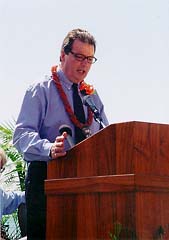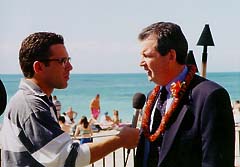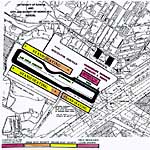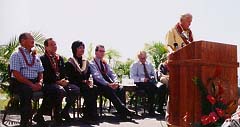©1999 SpeedCenter Publishing
 By Earl Ma, with photos by the author
By Earl Ma, with photos by the author
After three years of planning and three months of public speculation, CART stunned the racing world when it announced its' affiliation with the highly ambitious Hawaiian Super Prix project. With CART CEO Andrew Craig on hand, race organizers and local politicians formally unveiled the grand proposal at an hour-long press conference January 25 at the historic Royal Hawaiian Hotel in Honolulu, directly along the picturesque shores of Waikiki Beach.
 The inaugural event, scheduled for 1 pm local time (6 pm Eastern), Saturday,
November 13 at the Barbers Point Naval Air Station runway in Leeward Oahu,
promises a sizable bounty for CART's top drivers in a non-points paying race
held two weeks after the season finale in Fontana. Out of a whopping $10
million purse, the largest ever in auto racing history, the winner takes
home exactly half that amount. Last place pays a mere $245,000, which
eclipses what Donnie Beechler earned for finishing 32nd in the 1998
Indianapolis 500 ($132,300) and what John Andretti earned for finishing last
at this year's Daytona 500 ($91,751). Pole position is worth $250,000 in
itself "for approximately one minute's worth of skill and bravery, " in the
words of Super Prix co-founder Richard (Dick) Rutherford.
The inaugural event, scheduled for 1 pm local time (6 pm Eastern), Saturday,
November 13 at the Barbers Point Naval Air Station runway in Leeward Oahu,
promises a sizable bounty for CART's top drivers in a non-points paying race
held two weeks after the season finale in Fontana. Out of a whopping $10
million purse, the largest ever in auto racing history, the winner takes
home exactly half that amount. Last place pays a mere $245,000, which
eclipses what Donnie Beechler earned for finishing 32nd in the 1998
Indianapolis 500 ($132,300) and what John Andretti earned for finishing last
at this year's Daytona 500 ($91,751). Pole position is worth $250,000 in
itself "for approximately one minute's worth of skill and bravery, " in the
words of Super Prix co-founder Richard (Dick) Rutherford.
The top twelve drivers in 1999 season points will automatically receive invitations, with four promoter's option slots open to fill the field; officials did not give any criteria for how they will select these "wild card" entries. Ostensibly this could include drivers from Formula One and IRL, both of which will have concluded their own seasons by then. In contrast, the race conflicts with NASCAR's weekend in Homestead and the debut of Winston Cup at that facility. As for other possibilities, Rutherford suggested, "I know a couple of retired race drivers who would love to come out of retirement for that kind of money. Sorry, Mario! I guess those old guys were just born a couple years too late [obviously he meant to say: "too soon"]. We'll just have to leave this racing business to the young lions."
While no CART drivers or team owners attended the press conference, Craig
 |
| Overdressed for the beach |
Regarding the exotic location, which one reporter suggested directly one-ups IRL's season-ending race in Las Vegas (every other Hawaii resident's favorite vacation spot), Super Prix President David Greyson said, "where else would we bring CART's finest drivers after a long, grueling season? What better place exists than this Pacific paradise? However, our selection was not based solely on the romantic appeal of the Pacific islands. Hawaii has a long tradition of hosting professional sporting events. From the Pro Bowl, PGA tournaments, and the Ironman Triathalon, the state of Hawaii has repeatedly established itself as a premiere venue for world-class sports competition."
"People come (to Hawaii) from all over the world," Craig added, "and that's just like our sport. Drivers and team members come from all over the world to participate in our series...it's the championship that has a worldwide following, and I think that following is going to apply to this event. I am totally convinced there's going to be worldwide interest in the telecast of this event."
 |
| click on image for larger map |
In an unprecedented move which has disturbed some CART fans in the Continental US used to seeing all the races on network or cable TV for free, the race will air live on Pay Per View in the States and internationally in over 195 countries, reaching a worldwide audience of approximately 300 million viewers, many of whom "will be seeing the beauty of Hawaii for the first time," Grayson said. Adding to the incentive for fans to pay a reported $19.95 for the telecast is the chance for them to grab their own share of the pie, with one lucky viewer scoring a $1 million prize of his or her own for phoning in the correct answers to contest questions. "I might even watch it myself!" Rutherford joked.
 |
| Rutherford speaks |
Officials figure the inaugural race will cost $20 million to stage, including the purse, sanctioning fees, shipping cars and barriers, administrative costs, and so forth. Pay Per View revenues, ticket sales, and corporate sponsorships (with Sheraton hotels being the first on board) would cover these expenses. In the meantime, Rutherford said, "well, we're paying for it. We put the money up - we got what you call a performance bond and had that issued, so that we know everybody will be paid." He expects the average ticket price to follow those of other CART races - in the $40-70 range for a 3-day ticket.
Numerous commemorative events throughout the week will precede the Super Prix, including a charity golf tournament, Governor's Ball, parade, luaus, and a deep sea fishing extravaganza for all the drivers plus celebrities and local dignitaries.
Various podium speakers repeatedly referred to this event as the "Super Bowl of Auto Racing," thus usurping Indy and Daytona in one fell swoop. One who seized upon this football analogy in particular was former NFL great Russ Francis, now the sports coordinator for the Hawaii Tourism Authority. Recounting his involvement with the Pro Bowl, he mentioned how it "came to Hawaii in less than healthy condition...it suffered from player defections, no-shows, declining attendance. Hawaii joined together, I'll remind you, to breathe life into that game and work side by side with the NFL going on 19-20 years now to sellout crowds each year, NFL players endorsing the Pro Bowl in Hawaii...the players love to play here, and the fans in Hawaii love the players. That took an effort on all sides and all parties from the community on up." He expects no less from this all-star event and from local fans. "We have to make this happen. This race, the Hawaiian Super Prix, is Hawaii's gift to the sporting world."
 |
| Presenting the track |
Of the 50,000 to 100,000 spectator projection, tourists from the mainland would constitute approximately 30,000, with 17,000 more from overseas; the rest would be local fans. When asked about TV viewer demographics, Rutherford said, "that doesn't really mean whether they're gonna come here. Besides, I don't want them to come. I want them to buy (the Pay Per View)!"
Rutherford is known in CART circles as a founding figure of Indy Lights (then called the American Racing Series) as its' first president from 1985-87. Son Rich competed in Super Vees with some success in the mid-1980's, and he will work as the liaison PR and promotions director for the race at CART's mainland venues, among other responsibilities.
Rutherford says that while CART has a 3-year commitment to the Super Prix, the organizers are committed to the state for a full decade and "I hope 15 years." State officials, meanwhile, anticipate an annual financial impact of $85-90 million in revenue for Hawaii, with surprisingly very little or no expenditure from the state itself (unlike light rail transit and other lofty projects which required too much state funding).
No public funding at all? "Isn't that amazing," Rutherford replied.
The Super Prix marks the dramatic return of auto racing to the Hawaiian public's consciousness after exactly 40 years. Stock car racing at the revered Honolulu Stadium, a hugely popular spectator sport throughout the 1950's, ceased in 1959, a few months after 1953 NASCAR track champion Jerry Unser lost his life at Indy in his sophomore attempt at the 500. Maui's Danny Ongais, who ran drag races locally before moving to California, is the only Hawaii-born driver in CART history, with 6 career wins (all USAC) in an Indycar career spanning 11 years.
Rutherford first announced plans for the Super Prix in November, revealing information about the huge purse (which remains accurate) but precious little else. Initial plans suggested the race would be fully invitational like IROC, but this soon evolved into the present 12-and-4 scheme. In a neighborhood board meeting just eight days before the news conference, Rutherford remained surprisingly vague amid the bewildered constituents, saying little about the track and nothing about the sanctioning body, funding, or other increasingly crucial details with only nine months remaining before the target race date. All he revealed at the time, according to the Honolulu Advertiser, was the type of car: 950-horsepower, turbocharged, open-wheeled cars with top speeds of 190 mph. By process of elimination, one could jump to the conclusion that this could only mean CART Champ cars (not F1, not IRL, not Lights, not Atlantics, etc.), but even the most optimistic and loyal enthusiasts still found the notion of CART actually coming to Hawaii far-fetched.
"Now I can assure you this. With 5 million dollars on the line for the winner, this is certainly gonna tighten and focus (the drivers') attention on the day. I can only believe this will be one of the most exciting finishes, if not the most exciting finish in racing, ever," Craig added.
"No doubt there are a few people who are already dreaming about how they'll spend it."
Thus, the next millenium of auto racing begins early. Will the race live up to all its' enormous hype? Where will CART stand in the motorsports hierarchy after this? We shall know in another seven months!